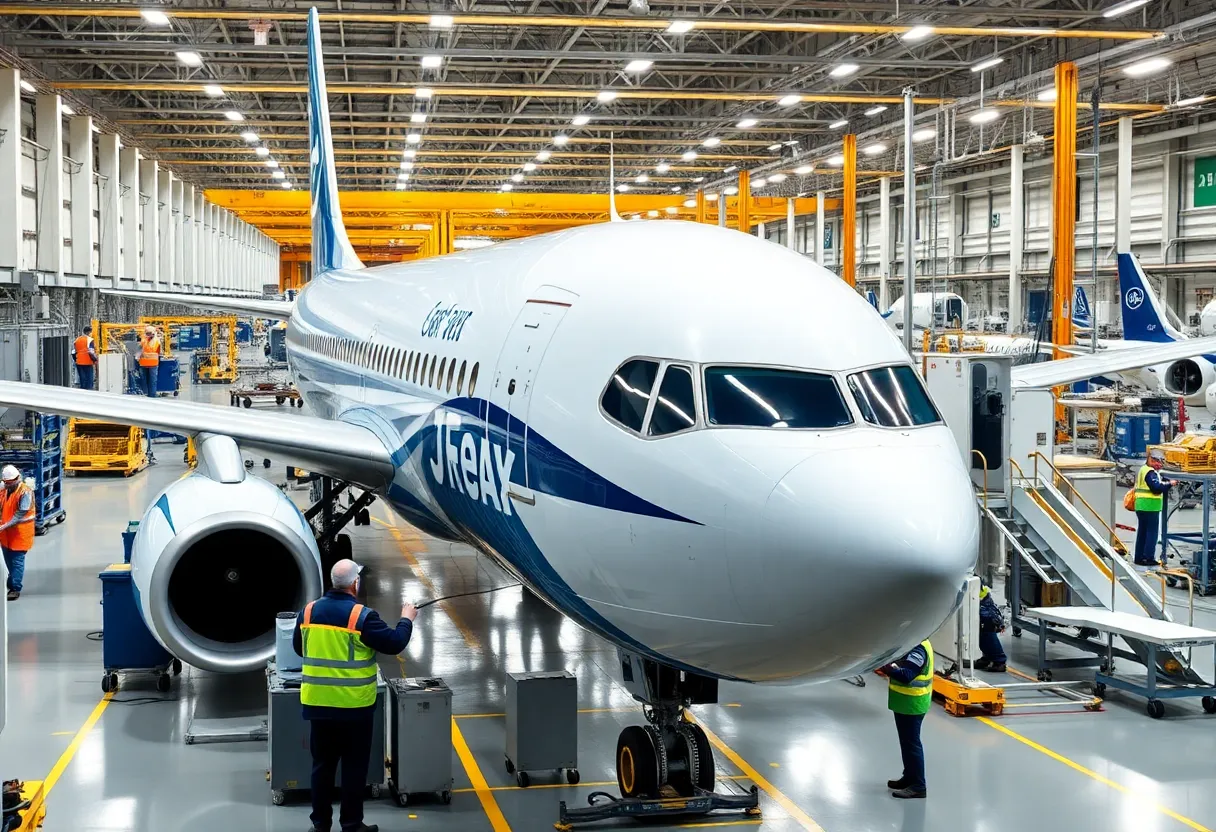Seattle, Washington, October 18, 2025
The Federal Aviation Administration has approved Boeing’s request to increase production of its 737 Max aircraft to 42 planes per month. This decision aims to address a backlog of airline orders and restore confidence in Boeing’s manufacturing process following a significant safety incident. The approval includes enhanced safety protocols and rigorous inspections to ensure that each aircraft meets federal standards. Economically, this move could create about 1,000 jobs across Boeing’s supply chain, benefiting the aerospace sector and improving service reliability for airlines.
FAA Approves Boeing’s Plan to Increase 737 Max Production
Seattle, Washington
The Federal Aviation Administration (FAA) has approved Boeing’s request to ramp up production of its 737 Max aircraft to 42 planes per month, marking a significant milestone nearly two years after a dramatic safety incident involving an Alaska Airlines flight. This decision comes as the aviation giant works to restore confidence in its manufacturing processes following the January 2024 event where a door plug component detached mid-flight, prompting widespread scrutiny and production halts.
The approval allows Boeing to accelerate output from its current rate of around 25 to 30 planes monthly, addressing a backlog of airline orders and helping stabilize the company’s supply chain. Safety remains at the forefront, with the FAA emphasizing that the production increase hinges on enhanced safety protocols and rigorous inspections to prevent future issues. These measures include additional quality control checks, updated training for workers, and closer oversight of supplier parts, ensuring that each aircraft meets stringent federal standards before delivery.
Economically, the move is expected to create opportunities in the aerospace sector. Boeing anticipates that fulfilling these increased production goals could add approximately 1,000 jobs across its supply chain, boosting employment in manufacturing, engineering, and logistics roles. This job growth could ripple through local communities near Boeing’s facilities, particularly in Washington state, where the company has a major presence. Airlines awaiting deliveries, such as Southwest, United, and Delta, stand to benefit from shorter wait times, potentially easing fare pressures and improving service reliability for passengers nationwide.
Background on the Door Plug Incident
The path to this approval traces back to the January 5, 2024, incident on Alaska Airlines Flight 1282, a Boeing 737 Max 9 operating between Portland, Oregon, and Ontario, California. Shortly after takeoff, a door plug panel blew out at 16,000 feet, causing rapid decompression but no serious injuries among the 171 passengers and crew. The National Transportation Safety Board (NTSB) investigation revealed that the panel was not properly secured due to missing bolts, pointing to lapses in Boeing’s assembly process at its Renton, Washington factory.
In response, the FAA grounded dozens of 737 Max 9 aircraft for inspections, uncovering additional concerns with door plugs on other planes. Boeing faced immediate production caps and a mandate to develop a comprehensive safety plan. Over the ensuing months, the company implemented fixes, including redesigning the door plug installation procedures and increasing whistleblower protections to encourage internal reporting of issues. The FAA’s review process involved multiple audits and data submissions from Boeing, confirming that the manufacturer had addressed key vulnerabilities before greenlighting the production hike.
Implications for Aviation Safety and Industry Recovery
This development underscores a broader effort within the aviation industry to balance growth with safety. The 737 Max family, Boeing’s most popular narrow-body jet, has been central to the company’s recovery since earlier setbacks, including the 2018 and 2019 crashes that led to a global grounding of the model. Today’s approval signals that regulators view Boeing’s improvements as sufficient to support expanded operations, though ongoing monitoring will be crucial.
For suppliers and partners, the ramp-up means steadier demand for components like engines from GE and CFM International, fuselages, and avionics systems. This could inject vitality into the global supply chain, which has struggled with post-pandemic disruptions and labor shortages. However, Boeing must navigate challenges such as skilled worker recruitment and material cost fluctuations to hit the 42-per-month target sustainably.
Passengers can expect indirect benefits, as more planes entering service may help airlines expand routes and reduce delays. Yet, the incident’s shadow lingers, reminding stakeholders of the importance of vigilance. The FAA has stated it will continue unannounced audits and require monthly production reports from Boeing to maintain accountability.
Longer-Term Outlook
Looking ahead, Boeing’s ability to meet this production rate will influence its market position against rival Airbus, which has gained ground during Boeing’s troubles. Successfully scaling up could help Boeing clear its order backlog of over 4,000 unfilled 737 Max orders, valued at hundreds of billions of dollars. This resurgence is vital not just for Boeing but for the U.S. economy, where aerospace contributes significantly to exports and innovation.
In summary, the FAA’s decision represents a cautious step forward, prioritizing safety enhancements while enabling economic gains. As Boeing proceeds, all eyes will be on whether it can deliver reliable aircraft at the new pace, rebuilding trust one flight at a time.
FAQ
What is the key decision made by the FAA regarding Boeing?
The FAA greenlit Boeing’s request to ramp up 737 Max production to 42 planes monthly, nearly two years post the Alaska Airlines door plug incident.
What underpins the FAA’s approval for increased production?
Safety enhancements and rigorous inspections underpin the decision.
What does Boeing anticipate from fulfilling airline orders?
Boeing anticipates fulfilling airline orders, potentially adding 1,000 jobs in the supply chain.
When did the Alaska Airlines door plug incident occur?
The incident occurred nearly two years ago, specifically in January 2024.
Key Features Chart
| Feature | Details |
|---|---|
| Production Increase | Ramp up to 42 planes monthly |
| Timeline | Nearly two years post Alaska Airlines door plug incident |
| Safety Measures | Enhanced safety protocols and rigorous inspections |
| Job Impact | Potentially adding 1,000 jobs in the supply chain |
| Regulatory Approval | FAA greenlit Boeing’s request |





